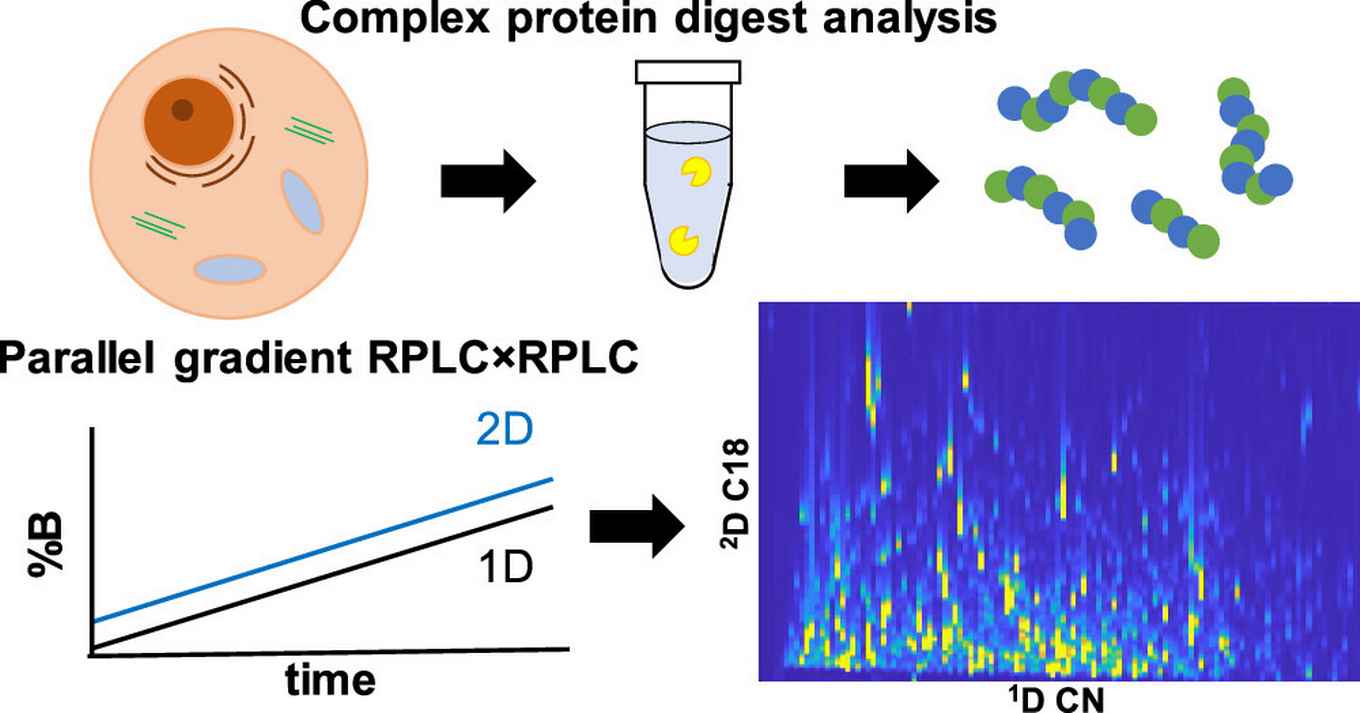Novel MS hyphenated separation methods for complex mixtures of peptides and proteins
29 May 2024
One paper, authored by PhD candidate Rick van den Hurk, describes an advanced two dimensional LC method. The other, by PhD candidate Ziran Zhai, reports on a nanoflow native ion exchange method. Both represent significant advancements to the toolbox for protein analysis.
Parallel gradients in 2DLC-HRMS analysis
Investigating the proteins in biological samples can help understand and identify diseases and improve the effectiveness of medication. To study proteins in these samples, they are typically digested into peptides and subsequently analyzed. The paper of Van den Hurk and coworkers describes the use of parallel gradients in two-dimensional liquid chromatography (LC×LC) hyphenated with high-resolution mass spectrometry (HRMS). The parallel-gradient concept omits the need for column re-equilibration and enables the use of the entire separation space. To assess its applicability to real complex samples, it was used in the analysis of a human IMR90 lung fibroblast cell line digest. There, it was able to identify significantly more proteins than the current state-of-the-art methods while using the same analysis time and at a lower solvent consumption. In general, the use of parallel-gradients achieves higher surface coverages and sensitivity at lower effective peak capacities. It allows for lower flow rates and maintains the sensitivity for low-abundant analytes.

Paper details: Rick S. van den Hurk, Bart Lagerwaard, Nathan J. Terlouw, Mingzhe Sun, Job J. Tieleman, Anniek X. Verstegen, Saer Samanipour, Bob W.J. Pirok, and Andrea F.G. Gargano: Comprehensive Two-Dimensional Liquid Chromatography–High-Resolution Mass Spectrometry for Complex Protein Digest Analysis Using Parallel Gradients. Anal. Chem. 2024, Publication date May 17, 2024. DOI: 10.1021/acs.analchem.4c02172
Read more: Parallel Gradients 2DLC-HRMS of complex protein digest
Nanoflow native ion exchange HRMS
Proteoforms are protein products arising from homologous genes as a result of sequence variations, alternative splicing, and post-translational modifications. They play a crucial role in a wide range of critical biological functions. The standard approach for their characterization is ‘bottom-up proteomics’ where their presence is inferred from peptides. The alternative approaches of ‘top-down’ proteomics and intact protein mass spectrometry often involve denaturing, which unfolds proteins and leads to the loss of non-covalent protein complexes. The paper of Ziran Zhai and coworkers presents a novel approach where nanoflow (250 or 500 nL min-1) strong cation exchange chromatography (SCX) is directly coupled to nano-electrospray-ionization (nESI) under native MS (nMS) conditions. Proteins were separated on packed capillary SCX columns and eluted according to their pI values by a salt-mediated pH gradient method. The low flow promoted desolvation/ionization efficiency allows for sensitive detection of low-abundant proteins and complexes. The method was successfully applied in the analysis of an E. coli cell lysate, revealing hundreds of proteins with masses up to 150 kDa. It provides a universal strategy to overcome detection limitations in native top-down proteomics.

Paper details: Ziran Zhai, Despoina Mavridou, Matteo Damian, Francesco G. Mutti, Peter J. Schoenmakers, and Andrea F. G. Gargano: Characterization of Complex Proteoform Mixtures by Online Nanoflow Ion-Exchange Chromatography-Native Mass Spectrometry. Anal. Chem. 2024, publication date May 21, 2024. DOI: 10.1021/acs.analchem.4c01760
Read more: Nanoflow IEC-HRMS to study complex proteoform mixtures
The SEparation and Mass spectrometry (SEMpre) group forms part of the Chemometrics & Advanced Separations Team (CAST), joining Analytical Chemistry researchers Andrea Gargano, Bob Pirok and researchers from the University of Amsterdam and VU University Amsterdam. They are also part of the Centre for Analytical Sciences Amsterdam (CASA).